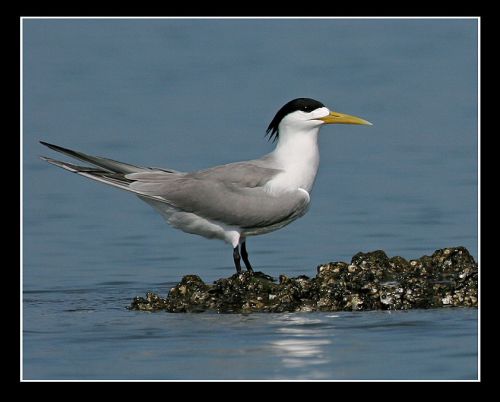Alternative name: Swift Tern, Greater Crested Tern, Crested Tern, Great Crested-Tern

Photo © by Karim Madoya
Lokawi, Sabah, Malaysia, 15 March 2007
- Thalasseus bergii
Sterna bergii
Identification
Length 43–53 cm (17-20¾ in)

Photo © by Joseph Morlan
East Point, Darwin, NT, Australia, 30 July 2014
Adult
- A large tern with a white forehead black cap that crests behind the head
- Bright white underparts, and gray back and wings.
- The bill is long, yellow, and slightly down-curved.
- Wings are long, extending beyond the tail when not in flight.
- Legs black.
- Sexes alike.
Non-breeding
Reduced black cap; crest reduced.
Immature
From Lesser Crested Tern by smudgy marks extending on to the neck in a semi-collar where other marks like bill shape are ambiguous
Juvenile
Barred with dark blackish brown. Has a dusky yellow-olive bill and smudgy head.
Similar Species
Caspian Tern is much larger with bright red bill. Lesser Crested Tern is smaller, paler above and has an orange, not yellow bill. Royal Tern is much paler above and has a rich orange bill. In breeding plumage, Great Crested Tern has a white forehead, while Royal Tern has the forehead black connecting to the black cap.
Distribution
Coasts of Africa, southern Asia and Australasia:
Northern Africa: occurs only in Egypt
Eastern Africa: Sudan, Eritrea, Djibouti, Somalia, Kenya, Tanzania, Zanzibar, Mozambique, Namibia
South Africa: KwaZulu-Natal
African Islands: Madagascar, Comoros, Seychelles
Middle East: Israel, Arabian Peninsula, Saudi Arabia, Yemen, Socotra, Oman, United Arab Emirates, Qatar, Bahrain, Kuwait, Iraq, Iran
Asia: China, Pakistan, India, Andaman and Nicobar Islands, Maldives, Sri Lanka, Bangladesh, Japan, Taiwan
Southeast Asia: Indochina, Myanmar, Laos, Vietnam, Cambodia, Thailand, Malaysia, Borneo, Malay Peninsula, Brunei, Singapore, Philippines, Indonesia, Greater Sundas, Sumatra, Java, Sulawesi, Lesser Sundas, Bali, West Timor, East Timor
Australasia: New Guinea, Papua New Guinea, Australia: New South Wales, Northern Territory, Queensland, South Australia, Tasmania, Victoria, Western Australia, Polynesia, Melanesia, Samoa, Micronesia, Fiji, Solomon Islands, Vanuatu, Tonga, New Caledonia, Micronesia
Taxonomy
Like its relatives, this species was formerly placed in the genus Sterna.
Subspecies
This is a polytypic species with four subspecies currently recognized:[1]
- T. b. bergii
- Namibia and South Africa; disperses to Mozambique - Dark grey above, slightly larger than thalassina, least white on head.
- T. b. thalassinus
- Breeds Tanzania, Seychelles, Aldabra and Rodrigues Island, and northern Madagascar; disperses north to Somalia, and south to southern Madagascar - Small and pale.
- T. b. velox
- T. b. cristatus
- Ryukyu Islands and southeastern China to the Philippines, the Sunda Islands, Wallacea, New Guinea, Australia, and the tropical Pacific Ocean (to southeastern Polynesia) - Like bergii, with tail, rump and back concolorous.
Races T. b. enigma of Islands off Mozambique, Zambezi River delta and Madagascar and T. b. gwendolenae of Western and north-western Australia no longer considered valid. Synonymized with nominate bergii and cristatus respectively.
Habitat
Tropical and subtropical coasts and oceanic islands. Restricted to continental shelf, venturing to about 3 km inland. More marine than Royal Tern.
Behaviour
Action
Forages by plunging from several meters above the surface to take fish. Noisy, often in flocks. A common species in its range.
Diet
Feeds mainly on fish (10–15 cm long); also opportunistically on squid, crabs, insects, termites, baby turtles and other aquatic prey.
Breeding
Monogamous but highly colonial. Nest is a depression in sand, usually unlined. Clutch size usually single egg, highly variable in color. Nesting season varies with latitude and location.
Vocalisation
Highly vocal, especially at nesting colonies. The territorial advertising call is a loud, raucous kirrak or kirrik. Juvenile gives thin, vibrating whistle.
Movements
Movement patterns mostly unknown. Many populations are more or less resident around breeding colonies.
References
- Clements, J. F., T. S. Schulenberg, M. J. Iliff, S. M. Billerman, T. A. Fredericks, B. L. Sullivan, and C. L. Wood. 2019. The eBird/Clements Checklist of Birds of the World: v2019. Downloaded from http://www.birds.cornell.edu/clementschecklist/download/
- Gill, F & D Donsker (Eds). 2019. IOC World Bird List (v9.2). doi : 10.14344/IOC.ML.9.2. Available at http://www.worldbirdnames.org/
- Avibase
- Gochfeld, M., Burger, J., Kirwan, G.M., Christie, D.A. & Garcia, E.F.J. (2019). Greater Crested Tern (Thalasseus bergii). In: del Hoyo, J., Elliott, A., Sargatal, J., Christie, D.A. & de Juana, E. (eds.). Handbook of the Birds of the World Alive. Lynx Edicions, Barcelona. (retrieved from https://www.hbw.com/node/54019 on 7 December 2019).
- Higgins, P. J.; Davies, S. J. J. F., eds. (1996). Handbook of Australian, New Zealand and Antarctic Birds: Volume 3: Snipe to Pigeons. Melbourne: Oxford University Press. ISBN 0-19-553070-5.
- Sinclair, I., Hockey, P.A.R., and Arlott, N. (2005). The Larger Illustrated Guide to Birds of Southern Africa. Struik, Cape Town. ISBN 978-1775840992
- Wikipedia contributors. (2018, June 17). Greater crested tern. In Wikipedia, The Free Encyclopedia. Retrieved 18:13, July 9, 2018, from https://en.wikipedia.org/w/index.php?title=Greater_crested_tern&oldid=846261713
- Dutson, G. (2011) Birds of Melanesia, Christopher Helm, London.
Recommended Citation
- BirdForum Opus contributors. (2025) Great Crested Tern. In: BirdForum, the forum for wild birds and birding. Retrieved 27 April 2025 from https://www.birdforum.net/opus/Great_Crested_Tern
External Links
GSearch checked for 2020 platform.1







